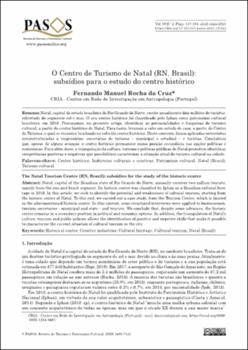O Centro de Turismo de Natal (RN, Brasil): subsídios para o estudo do centro histórico
Date
2021Abstract
Natal, capital do estado brasileiro do Rio Grande do Norte, recebe anualmente dois milhões de turistas,
sobretudo do segmento sol e mar. O seu centro histórico foi classificado pelo Iphan como património cultural
brasileiro, em 2010. Procuramos, no presente artigo, identificar as potencialidades e fraquezas do turismo
cultural, a partir do centro histórico de Natal. Para tanto, levamos a cabo um estudo de caso, a partir do Centro
de Turismo, o qual se encontra localizado no referido centro histórico. Neste contexto, foram aplicadas entrevistas
semiestruturadas a empresários, secretários de turismo – municipal e estadual – e turistas. Concluímos
que, apesar de alguns avanços, o centro histórico permanece numa posição secundária nas opções políticas e
económicas. Para além disso, a triangulação da cultura, turismo e políticas públicas de Natal permitem identificar
competências positivas e negativas que possibilitam caracterizar a situação atual do turismo cultural na cidade. Natal, capital of the Brazilian state of Rio Grande do Norte, annually receives two million tourists,
mainly from the sun and beach segment. Its historic centre was classified by Iphan as a Brazilian cultural heri‐
tage in 2010. In this article, we seek to identify the potential and weaknesses of cultural tourism, starting from
the historic centre of Natal. To this end, we carried out a case study, from the Tourism Centre, which is located
in the aforementioned historic centre. In this context, semi-structured interviews were applied to businessmen,
tourism secretaries - municipal and state - and tourists. We conclude that, despite some advances, the historic
centre remains in a secondary position in political and economic options. In addition, the triangulation of Natal's
culture, tourism and public policies allows the identification of positive and negative skills that make it possible
to characterize the current situation of cultural tourism in the city.





